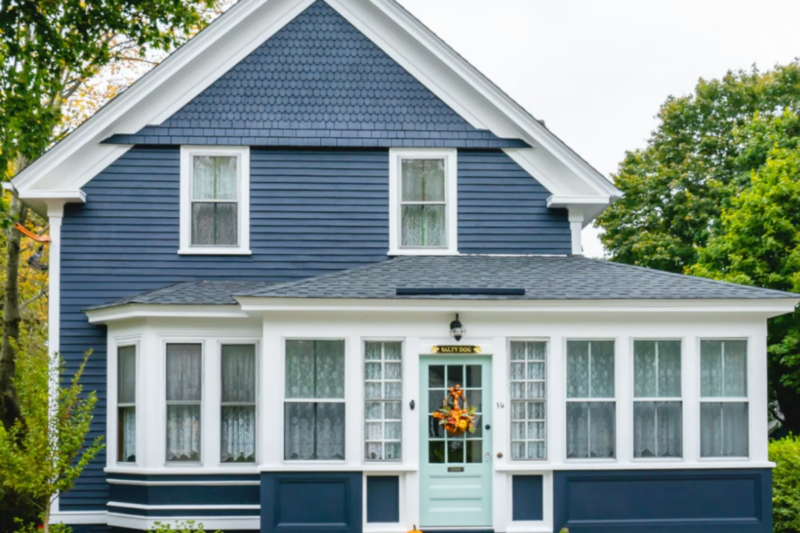After a long, wet winter, your home’s exterior might be showing some wear and tear. Peeling paint, water damage, and maybe a little wood rot’s creeping in around the edges?
So, why wait until summer? If you’re thinking about an exterior paint job, here’s why right now is a great time to schedule it.
The Perfect Weather Window
Painting your home’s exterior isn’t just about picking the right color—it’s about choosing the right season. And in Rhode Island, early spring offers some of the best conditions:
- Not Too Hot, Not Too Cold – Paint needs moderate temperatures to adhere properly. If it’s too cold, it won’t dry correctly. Too hot, and it can bubble or dry too quickly. Early spring provides that perfect range.
- Lower Humidity for a Beautiful Finish – High humidity can cause paint to take longer to dry, leading to uneven finishes. Early spring tends to have lower moisture levels, meaning your new paint job won’t suffer from sticky, slow-drying issues.
- Beat the Summer Rush – Summer schedules fill quickly, making now a great opportunity to get ahead of the crowd. Whether you paint now or paint later, it’s still smart to call soon.
Preventing Further Damage from Winter Wear & Tear
Rhode Island winters are not gentle. Between snow, ice, and fluctuating temperatures, your home’s exterior gets put through the wringer. Here’s why acting now can save you trouble down the road:
- Seals & Protects Surfaces – Painting in early spring helps seal exposed wood, preventing moisture damage before the humidity of summer sets in.
- Prevents Wood Rot & Structural Issues – Cracks and peeling paint allow water to seep in, leading to rot and long-term structural damage. A fresh coat acts as a protective barrier.
- Stops UV Damage Before It Starts – Summer sun is relentless, and UV rays can cause paint to fade faster. A fresh paint job in spring ensures your home is shielded before those rays do their worst.

Pro Tips for a Successful Exterior Paint Job in Rhode Island
Here’s how to get the best results and keep your home looking fresh for years to come.
- Choose High-Quality, Weather-Resistant Paint – Rhode Island’s coastal climate is beautiful, but it’s also tough on home exteriors. Salt air, humidity, and fluctuating temperatures can cause cheap paint to fade, crack, or peel too soon. Investing in high-quality, weather-resistant paint means your home stays protected and looks great no matter what Mother Nature throws at it.
- Prep is Key – Think of painting like building a house—you wouldn’t start without a solid foundation. Scraping off old, peeling paint, sanding rough spots, and applying a quality primer are just as important as the final coat. Skimp on prep work, and you’ll be repainting much sooner than you’d like.
- Hire Professionals for the Best Results – Sure, DIY painting sounds doable—until you’re three hours in, stuck on a ladder, and realizing that trim work is a lot harder than it looks. A professional crew has the right tools, experience, and techniques to get the job done efficiently, safely, and with a beautiful finish. Plus, they handle the cleanup, so you don’t have to spend your weekend scraping paint off your driveway.
Looking for a RI Painting Company?
Even with the best prep and materials, exterior painting is a big job that requires skill, precision, and an eye for detail. That’s where Dennis Moffitt Painting comes in.
With years of experience and a reputation for top-quality work, our team knows how to handle Rhode Island’s unique climate challenges, ensuring a durable, beautiful finish that stands the test of time. From careful surface preparation to expert application, we take care of everything—so you don’t have to!
Frequently Asked Questions (FAQs)
Q: What’s the best temperature range for exterior painting?
A: Ideally, between 50°F and 85°F. Early spring in Rhode Island usually falls right into this sweet spot, making it perfect for painting.
Q: How long does exterior paint take to dry in spring conditions?
A: Most exterior paints dry to the touch within a few hours, but full curing can take a few days. With mild spring temperatures, the drying process is optimal—fast but not too fast.


